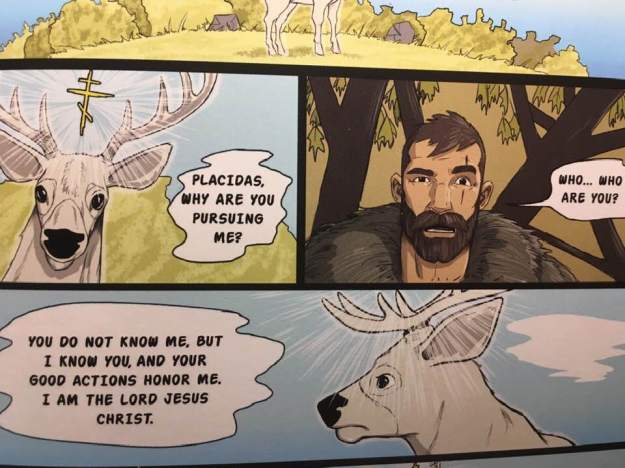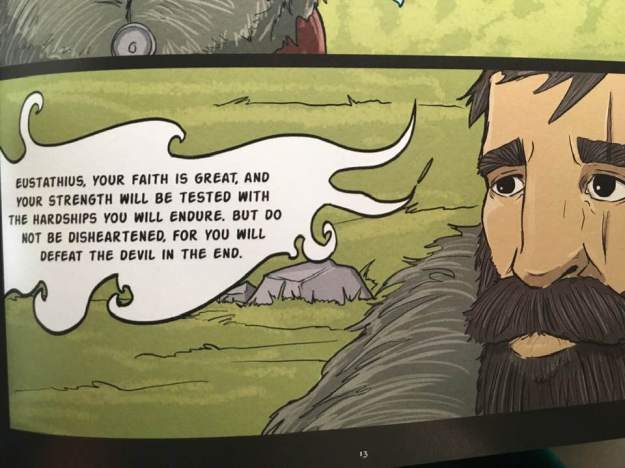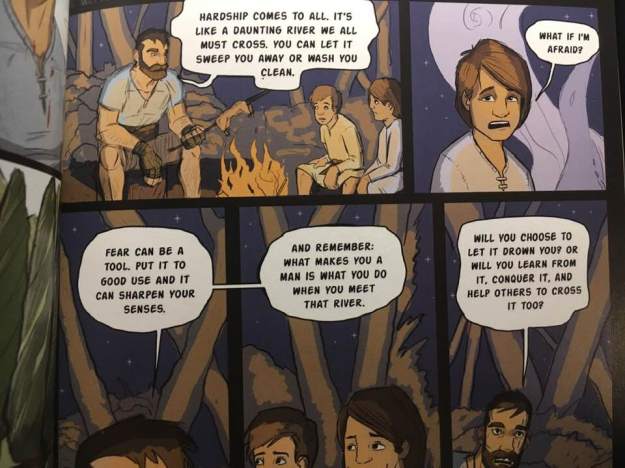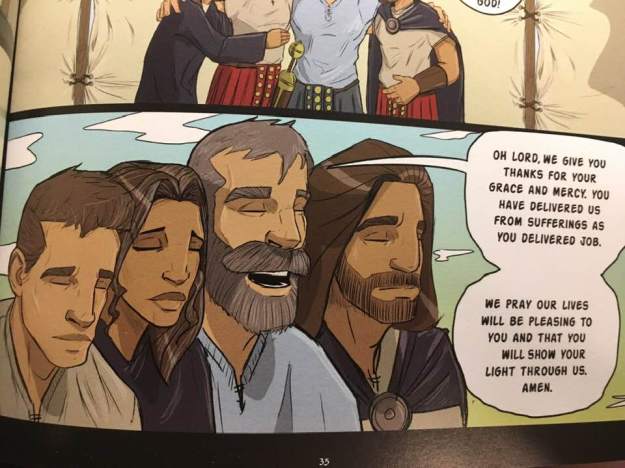(note: the emailed materials in the subscription arrive in full color, but are depicted here in black and white)
“You’ve got mail!” Oh, how I loved to hear these words when I was a child! It was the same for my children as they grew up, as well. Each piece of mail “just for them” was met with great enthusiasm and eagerness. At least in our family’s experience, it is a joy for children to receive mail of their very own!
Did you know that there is an Orthodox resource that will send your child(ren) mail of their own? And this is not just any old mail: this mail builds the faith of its recipients, preparing them for each Sunday’s Divine Liturgy! The resource is called SaintsBox.com, and while most SaintsBox mail is delivered electronically, some of it arrives via the postal service. SaintsBox.com offers two different weekly email subscriptions, as well as optional accoutrements such as a “Saint of the Month” vinyl icon cards subscription (complete with a small tin for housing the collection), and other related products which are sent through the postal service. The weekly email subscriptions at SaintsBox.com are geared towards two different age levels of children. Each aims to “reinforce what the Church has already established so our children will embrace the True Faith for life!” (home page, https://www.saintsbox.com/)
“St. John’s Clubhouse” (named after St. John Maximovich of San Francisco) is the SaintsBox email subscription that is full of ways to help children ages 4-8 prepare for Sunday’s Liturgy. A cast of characters called “the Clubhouse Kids” help the “clubhouse members” learn something about Sunday’s Gospel by sharing a related “story from their life” that bring the Gospel reading to life. They include the passage, so that parents and children can read the Gospel reading together before the Liturgy. They also challenge clubhouse members to anticipate or look for a particular thing during the upcoming Sunday Liturgy. This may include explaining an unfamiliar vocabulary word or upcoming event in the life of the Church. A printable sheet including a beautiful line-art icon (by Kiah Boyd) and a brief explanation will give the member an opportunity to learn more about the saint or featured feast/event for that particular Sunday. Find more information about St. John’s Clubhouse here: https://www.saintsbox.com/st-johns-clubhouse/.
“TQ6:21” is the SaintsBox email subscription which is actually a treasure quest for 8-12 year olds. Named for Matthew 6:21 (“for where your treasure is, there will your heart be also”), this subscription club helps its readers seek treasures of the Faith in the context of the Scriptures. In order to complete the puzzles in each week’s quest, “questers” need to read the Epistle and Gospel readings for the forthcoming Sunday Liturgy. In the context of clues and riddles, questers will learn about the Faith, the Scriptures, the saints, and more. Find more information about TQ6:21 here: https://www.saintsbox.com/tq621/.
Both subscriptions offer activities that parents and children can experience together, or parents can participate with part of the adventure, and the children can do the rest. (SaintsBox suggests that parents of the 4-8 year olds will likely spend 15 minutes per week and parents of 8-12 year olds, only 5-10 minutes each week, most of which is reading the Scripture passages together.) In other words, this subscription will also help the parents prepare for Sunday’s Liturgy as well, but it is not a huge time commitment!
Besides the two email subscriptions, SaintsBox.com also offers materials such as their SaintsBox, which is a pocket-sized tin filled with a baker’s dozen vinyl icon cards, each written by Elina Pelikan and featuring a different saint or event. (The SaintsBox is also available as a larger set which includes information sheets about each saint and an olive wood cross from the Holy Land.) SaintsBox.com’s tin “Trisagion Pocket Prayer Corner” includes the trisagion prayer; a vinyl icon of Christ, the Theotokos, and St. John the Forerunner; and an olive wood cross. Each of the vinyl icon cards are also available for individual purchase. So if you have a child who particularly loves one of the featured saints, you may wish to have just that saint’s card mailed to them. (Vinyl icons include: Christ/Theotokos/St. John the Forerunner; St. Patapios; St. Katherine of Alexandria; St. Jonah Bishop of Manchuria; the Nativity of the Theotokos; the 7 Holy Youths of Ephesus; Sts. Aquila and Priscilla; St. Columba of Iona; St. Irene the Great Martyr; St. Mary of Egypt; St. Patrick; St. Haralambos; St. Mugo; and St. John of San Francisco.)
We have seen samples of SaintsBox.com’s materials and would highly recommend this resource to Orthodox parents and teachers with children aged 4-12. The subscription materials are appealing and fun but also quite helpful. The icon cards/tin sets are sturdy, useful and interesting. The artwork is beautifully tasteful and engaging. SaintsBox.com’s materials will help Orthodox children (and the adults in their life) grow closer to Christ and His Church, one Sunday’s Gospel reading at a time.
If your child (or grandchild, Sunday Church school student, or godchild) enjoys getting mail of their own, we encourage you to check out SaintsBox.com. Whether you decide to mail a vinyl saint card to them, or to send a full subscription to the program, your child(ren) will enjoy receiving the mail that comes their way. And this extraordinary mail will help them (and you!) to grow closer to Christ and His Church!
Here is a little more information about SaintsBox.com and its offerings which may be of help to you:
***
“Our goal is to help children engage with more of the service and make deeper connections with Christ and His Saints.” ~ Annalisa Boyd, creator/writer of SaintsBox.com
Read more from her, and meet the creative team behind this wonderful subscription service here: https://www.saintsbox.com/about-2/
***
“Welcome to St. John’s Clubhouse, a subscription box club for your 4-8 year old. As parents, we understand the importance of instilling a love for Christ and His Church in the hearts of our children. We want them to embrace the True Faith as taught through Holy Tradition and the Living Church, but it’s hard to know where to start. St. John’s clubhouse offers the tools you need to help prepare your child to participate more fully in the Divine Liturgy each week. They will become friends with the Clubhouse Kids as they share from the Holy Scriptures, meet a Sunday saint and… do activities that inspire them to live the faith in every life situation. As you know, kids this age are CONSTANTLY learning. Providing teaching materials that feel like play, opens the door for your child to make long lasting positive connections between Church and home.” ~from the SaintsBox facebook page, Sept. 18, 2018
Find more information about St. John’s Clubhouse here: https://www.saintsbox.com/st-johns-clubhouse/
***
“TQ6:21 (Treasure Quest – Matthew 6:21 “Where you treasure is, there your heart will be also”)
We have all been called to the challenging and amazing life-long quest of storing up treasure for heaven by being transformed into the image of Christ. This quest, as you well know, is a matter of life and death, and our kids need all of the tools that the Church has to offer if they are to endure to the end. In order to help our children on that journey into Life, we have created the TQ6:21 program, which provides practical and engaging ways for kids to learn to own their faith and live it daily. We have aimed, in our theming of the activities, to tap into the natural love for adventure of 8-12 year-olds, helping them to develop their unique talents, godly character, a deeper understanding of their faith, and a lasting love for Holy Tradition as expressed in the living Church — all while just plain having fun! We’ve prepared this guide for you as the adult assisting them, to help explain the basic format of the program, and how it is designed to function.” ~from the SaintsBox facebook page, Sept. 18, 2018
Find more information about TQ6:21 here: https://www.saintsbox.com/tq621/
***
Watch SaintsBox creator Annalisa Boyd’s video podcast “The Ascetic Lives of Mothers”, in which she introduces SaintsBox, here: https://www.youtube.com/watch?v=b7Xnl-UNAFo&feature=youtu.be&fbclid=IwAR09Efb4p7lgNkfcsken3bSSCL3jP7c5CO3HhCNK2vc9JosCKl9e8lAqfFs (Note: at the time of this podcast, the subscriptions were not all electronic. The podcast does a good job of describing the program and how children have interacted with it. However, several times in the podcast Annalisa mentions receiving the subscription items in the mail. Listeners will need to keep in mind that the subscriptions are now emailed, not snail-mailed to the child.)
***
Find a sample of the beautiful icon line art which Kiah Boyd creates for St. John’s Clubhouse here. (This one was for Pentecost.) https://www.facebook.com/2088291571190702/photos/a.2169450139741511/2497858676900654/?type=3&theater
***
“I just love Saint John of San Francisco! Our family had the amazing opportunity to visit his relics when we lived in California. We got to go to the home that had been the location of the orphanage he began in San Francisco. We got to sit in his chair in his cell and say the Our Father. We even visited the original wooden church he had established and were blessed to have his Philonion (the cape part of his vestments) draped over us as the priest prayed for our family. From then on, each time we have seen an icon of Saint John, it has been like seeing a dear friend. That is our goal with presenting these icon cards…” ~ Annalisa Boyd, offering a bit of the back-story of the St. John of San Fransisco icon card available from SaintsBox.com at https://www.saintsbox.com/product/saint-john-of-san-francisco-saint-card/
***
.













